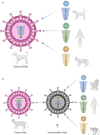Genetic characterization and evidence for multiple reassortments of rotavirus A G3P[3] in dogs and cats in Thailand
- PMID: 38855413
- PMCID: PMC11157116
- DOI: 10.3389/fvets.2024.1415771
Genetic characterization and evidence for multiple reassortments of rotavirus A G3P[3] in dogs and cats in Thailand
Abstract
Rotavirus A (RVA) causes gastroenteritis in humans and animals. The zoonotic potential of RVA has been reported and raises major concerns, especially in animal-human interface settings. The study aimed to characterize and investigate the genetic diversity among RVAs in dogs and cats in Thailand. We collected 572 rectal swab samples from dogs and cats in Bangkok animal hospitals from January 2020 to June 2021. The one-step RT-PCR assay detected RVAs in 1.92% (11/572) of the samples, with 2.75% (8/290) in dogs and 1.06% (3/282) in cats. Two canine RVA and one feline RVA were subjected to whole genome sequencing. Our results showed that all three viruses were identified as RVA genotype G3P[3]. The genetic constellation of RVAs is unique for different species. For canine RVAs is G3-P [3]-I3-R3-C3-M3-A9-N2-T3-E3-H6, while Feline RVA is G3-P [3]-I8-R3-C3-M3-A9-N3-T3-E3-H6. Notably, both canine and feline RVAs contained the AU-1 genetic constellation with multiple reassortments. The results of phylogenetic, genetic, and bootscan analyses showed that canine RVAs may have reassorted from dog, human, and cat RVAs. While feline RVA was closely related to RVAs in humans, bats, and simians. This study provided genetic characteristics and diversity of RVAs in dogs and cats and suggested possible multiple reassortments, suggesting the zoonotic potential of the viruses. Thus, public health awareness should be raised regarding the zoonotic potential of RVAs in dogs and cats. Further studies on RVAs on a larger scale in dogs and cats in Thailand are needed.
Keywords: cats; dogs; genetic characterization; interspecies transmission; reassortment; rotavirus A.
Copyright © 2024 Chamsai, Charoenkul, Udom, Jairak, Chaiyawong and Amonsin.
Conflict of interest statement
The authors declare that the research was conducted in the absence of any commercial or financial relationships that could be construed as a potential conflict of interest.
Figures



Similar articles
-
Unusual G3P[10] bat-like rotavirus strains detected in children with acute gastroenteritis in Thailand.J Med Virol. 2024 Oct;96(10):e70014. doi: 10.1002/jmv.70014. J Med Virol. 2024. PMID: 39420695
-
Complex evolutionary patterns of two rare human G3P[9] rotavirus strains possessing a feline/canine-like H6 genotype on an AU-1-like genotype constellation.Infect Genet Evol. 2013 Jun;16:103-12. doi: 10.1016/j.meegid.2013.01.016. Epub 2013 Feb 9. Infect Genet Evol. 2013. PMID: 23403096
-
Equine G3P[3] rotavirus strain E3198 related to simian RRV and feline/canine-like rotaviruses based on complete genome analyses.Vet Microbiol. 2013 Jan 25;161(3-4):239-46. doi: 10.1016/j.vetmic.2012.07.033. Epub 2012 Aug 21. Vet Microbiol. 2013. PMID: 22959604
-
Genetic characteristics and analysis of a novel rotavirus G3P[22] identified in diarrheic feces of Korean rabbit.Infect Genet Evol. 2019 Sep;73:368-377. doi: 10.1016/j.meegid.2019.06.003. Epub 2019 Jun 4. Infect Genet Evol. 2019. PMID: 31173932 Free PMC article.
-
Genotype constellation and evolution of group A rotaviruses infecting humans.Curr Opin Virol. 2012 Aug;2(4):426-33. doi: 10.1016/j.coviro.2012.04.007. Epub 2012 Jun 9. Curr Opin Virol. 2012. PMID: 22683209 Review.
Cited by
-
Genomic revelations: investigating rotavirus a presence in wild ruminants and its zoonotic potential.Front Vet Sci. 2024 Aug 15;11:1429654. doi: 10.3389/fvets.2024.1429654. eCollection 2024. Front Vet Sci. 2024. PMID: 39211480 Free PMC article.
References
LinkOut - more resources
Full Text Sources
Miscellaneous

